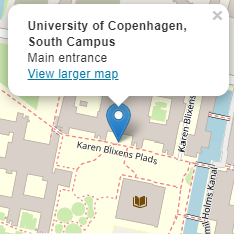L2 intercultural awareness and identity construction
Seminar.
Programme
|
13:00-13:15 |
Welcome and presentation |
Jan Lindschouw & Natalia Morollón Martí (University of Copenhagen) |
|
13:15-14:15 |
The global citizen and intercultural learning |
Karen Risager (Roskilde University) & Lone K. Svarstad (University College Copenhagen) |
|
14:15-15:00 |
The Intercultural Dialogue: Art, Language and Identity |
Alba Meldialdea (Universidad de Navarra) |
|
15:00-15:30 |
Coffee break |
|
|
15:30-16:15 |
Intercultural awareness in the French as a Foreign Language classroom |
Stephanie Löbl (University of Copenhagen/University College Copenhagen) |
|
16:15-17:00 |
Developing young learners’ intercultural competence using picture books – the attitudinal dimension in lower-primary English teaching |
Karoline Søgaard (University of Copenhagen/University College Copenhagen) |
|
17:00-17:15 |
Concluding remarks |
Jan Lindschouw & Natalia Morollón Martí (University of Copenhagen) |
Abstracts
Karen Risager & Lone K. Svarstad
The Global Citizen and Intercultural Learning
The lecture presents our new book that appeared this summer. It is in Danish: Verdensborgeren og den interkulturelle læring [The Global Citizen and Intercultural Learning].
The book addresses teachers and teacher educators at all educational levels and in all subjects, but with an empirical focus on the teaching of English, German and French in Danish lower secondary education. The choice of the term ‘global’ is taken very seriously in the book: Learning materials as well as the teaching itself are seen as windows to the world and as contributing in various ways to the global education of students. What images of the (complex and multicultural) world are being furthered in language teaching and other subjects such as social studies, history and geography? The six central chapters deal with different dimensions of images of the world:
- Where are we in the world? (a national approach)
- Where are we in the world? (a transnational approach)
- What images do we meet? (a visual literacy approach)
- Whom do we meet? Who are we? (a Cultural Studies approach)
- What problems do we take up? (a citizenship education approach)
- Who has written this and why? (a critical media literacy approach)
In the lecture, we will present some examples of intercultural learning processes – from noticing over comparing and reflecting to interacting and acting. Among the various processes we will emphasise three: The students’ development of their identities as global citizens, their development of perspective, awareness, and their training in contextualisation – locally, nationally and globally.
Alba Meldialdea
The Intercultural Dialogue: Art, Language & Identity
On a growing concern of postsecondary institutions for preparing students to live in a globalized world, it becomes imperative to more closely examine how best to develop pedagogical practices in SLA that could contribute to common good and intercultural dialogue.
To this end, I pursue an approximation to intercultural dialogue from a sociocultural perspective that could enable study abroad students in Pamplona to sense and grow within their social situation of development while improving their language proficiency. Giving the dynamic interrelation between language and culture, I propose to use an art-based approach where art can be developed as a means of: (1) Reception and interpretation of cultural artifacts, (2) Articulation and creation of thought, and (3) Origination of intercultural bonds.
Therefore, the aim of my research project is to find complementary ways of thought and expression that could enable study abroad students to project their inner-voice when confronting cultural differences in a foreign country. By blurring the boundaries between language and culture through art practices, the student might grow its intercultural sensibility, what I believe could contribute enhancing self-concept clarity.
Stephanie Löbl
Intercultural awareness in the French as a Foreign Language classroom
To what extent is intercultural awareness a part of the practices of French teachers? And are they vocal about and/or explicitly aware of their own representation/expression?
I will present data from 6 interviews and classroom observations with French teachers from all over Denmark. During the interviews we have discussed the notion of culture and intercultural competence and how they implement/use/present it in their teaching. I analyse their cultural perspective and understanding of the intercultural (communicative) competence.
Most of the teachers chose to invite me into a class in which they had specific focus on culture whereas few explicitly told me it was cultureless. I will include examples from my textbook analysis when relevant. I might also present data collected via a questionnaire with 91 participants as a supplement.
Karoline Søgaard
Developing young learners’ intercultural competence using picture books – the attitudinal dimension in lower-primary English teaching
The ability to engage in intercultural encounters is a central competence in our increasingly diverse societies, globally and locally. Intercultural competence is a central aim of teaching English in the Danish primary school according to the National Curriculum. However, research shows that this dimension of English as a subject is underdeveloped, especially in relation to young learners. The presentation will introduce a project whose aim it is to research how the teaching of English in lower-primary education can support the development of students’ intercultural competence through a picturebook-based approach. The presentation will focus on the attitudinal dimension of IC which is considered central within the field of intercultural pedagogy for young learners by earlier research, and tentatively suggest how carefully selected picture books might support the development of said dimension.

